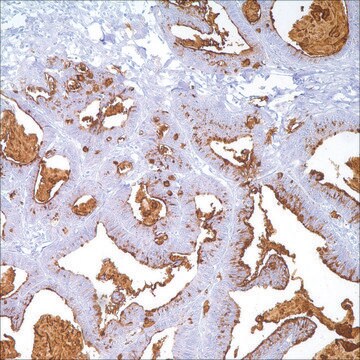ABE1451
Anti-phospho BRD4 (Ser492)
from rabbit
Synonym(s):
Bromodomain-containing protein 4, MCAP, Mitotic chromosome-associated protein, Protein HUNK1
About This Item
Recommended Products
biological source
rabbit
Quality Level
antibody form
affinity isolated antibody
antibody product type
primary antibodies
clone
polyclonal
species reactivity
mouse, human
species reactivity (predicted by homology)
rat (based on 100% sequence homology)
technique(s)
dot blot: suitable
immunocytochemistry: suitable
western blot: suitable
NCBI accession no.
UniProt accession no.
shipped in
wet ice
target post-translational modification
phosphorylation (pSer492)
Gene Information
human ... BRD4(23476)
General description
Specificity
Immunogen
Application
Western Blotting Analysis: A 1:500 dilution from a representative lot detected Brd4 Ser493 (equivalent to human Ser492) phosphorylation in lysate from 12-day cultured E16.5 embryonic mouse cortical neurons. Prior phosphatase treatment of the lysate abolished target band detection (Courtesy of Erica Korb, Ph.D. Rockefeller University, New York, U.S.A.).
Dot Blot Analysis: A representative lot detected BRD4 phosphopeptide with pSer492 or dual pSer492/494 phosphorylation (equivalent to mouse Ser493/495), but not the corresponding non-phosphorylated peptide or peptide with only pSer494 phosphorylation (Korb, E., et al. (2015). Nat. Neurosci. 18(10):1464-1473).
Western Blotting Analysis: A representative lot detected Brd4 Ser493 (equivalent to human Ser492) phosphorylation induction upon BDNF stimulation of cultured E16.5 embryonic mouse cortical neurons from C57BL/6 mice. Pre-treatment of neurons with CK2 inhibitor 4,5,6,7-tetrabromobenzotriazole (TBB; Cat. No. 218697) before BDNF stimulation or phosphatase treatment of the lysate prior to immunoblotting abolished target band detection (Korb, E., et al. (2015). Nat. Neurosci. 18(10):1464-1473).
Epigenetics & Nuclear Function
Quality
Western Blotting Analysis: A 1:1000 dilution of this antibody detected Brd4 Ser492 phosphorylation in 10 µg of human induced pluripotent stem cell (iPSC) lysate.
Target description
Physical form
Storage and Stability
Other Notes
Disclaimer
Not finding the right product?
Try our Product Selector Tool.
Storage Class Code
12 - Non Combustible Liquids
WGK
WGK 1
Flash Point(F)
Not applicable
Flash Point(C)
Not applicable
Certificates of Analysis (COA)
Search for Certificates of Analysis (COA) by entering the products Lot/Batch Number. Lot and Batch Numbers can be found on a product’s label following the words ‘Lot’ or ‘Batch’.
Already Own This Product?
Find documentation for the products that you have recently purchased in the Document Library.
Our team of scientists has experience in all areas of research including Life Science, Material Science, Chemical Synthesis, Chromatography, Analytical and many others.
Contact Technical Service








